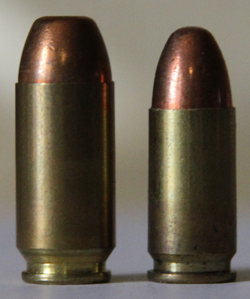Loading AI tools
Pistol cartridge designed by Evan Whildin From Wikipedia, the free encyclopedia
The .41 Action Express is a pistol cartridge developed in 1986 to reproduce the performance of the .41 Magnum police load (which is a reduced load) in semi-automatic pistols.[2]
| .41 Action Express | ||||||||||||||||
|---|---|---|---|---|---|---|---|---|---|---|---|---|---|---|---|---|
 A .41 AE cartridge next to a 9×19mm Luger cartridge for size comparison. | ||||||||||||||||
| Type | Handgun | |||||||||||||||
| Place of origin | United States Israel | |||||||||||||||
| Production history | ||||||||||||||||
| Designer | Evan Whildin | |||||||||||||||
| Designed | 1986 | |||||||||||||||
| Manufacturer | Action Arms | |||||||||||||||
| Produced | 1986–2005 | |||||||||||||||
| Specifications | ||||||||||||||||
| Case type | Rebated, straight | |||||||||||||||
| Bullet diameter | .410 in (10.4 mm) | |||||||||||||||
| Neck diameter | .434 in (11.0 mm) | |||||||||||||||
| Base diameter | .435 in (11.0 mm) | |||||||||||||||
| Rim diameter | .394 in (10.0 mm) | |||||||||||||||
| Rim thickness | .045 in (1.1 mm) | |||||||||||||||
| Case length | .866 in (22.0 mm) | |||||||||||||||
| Overall length | 1.17 in (30 mm) | |||||||||||||||
| Case capacity | 21.60 gr H2O (1.400 cm3) | |||||||||||||||
| Rifling twist | 1 in 14.2 in (360 mm) | |||||||||||||||
| Primer type | Small pistol | |||||||||||||||
| Maximum pressure | 35,000 psi (240 MPa) | |||||||||||||||
| Ballistic performance | ||||||||||||||||
| ||||||||||||||||
| Source(s): Hodgdon [1] | ||||||||||||||||
The .41 Action Express was designed by Evan Whildin, vice president of Action Arms, in 1986.[citation needed] It was based on the .41 Magnum case, cut down to fit in a 9×19mm Parabellum frame, and using a rebated rim. Performance was compared to the ballistics of the 41 Magnum police load.[2] The .41 AE was thought to be a very attractive concept, as the rebated rim allows a simple change of barrel, mainspring, and magazine to convert many 9mm guns to 41 AE.[2]
The powerful 10mm Auto cartridge, which had been suffering from poor acceptance from its start in the early 1980s, was eventually accepted by the FBI in a reduced power, subsonic loading. Smith & Wesson then decided the 10mm Auto was too much cartridge for the reduced power loading, and that the .45 ACP sized guns that chambered it were too heavy and bulky; out of this came the .40 S&W, a shortened 10mm Auto case, designed to fit in a 9mm-sized gun, with a reduced pressure loading that allowed a lighter, easier to shoot gun.[3][4] Because most ammunition manufacturers backed the .40 S&W, there was little use for the very similar .41 AE, so production of both firearms and ammunition was soon phased out;[2] it was designated as an 'inactive' cartridge by SAAMI in January 2005.[5]
The .41 AE was doomed by circumstance to obscurity, but the concept of using a rebated rim to allow easy cartridge interchangeability was not lost. The .50 Action Express, developed by Magnum Research for the Desert Eagle pistol, uses a similar rebated rim that is the same diameter as the .44 Magnum.[6] This allows a caliber change with replacement of just the barrel and magazine.
The .41 AE can be ballistically similar to the .40 S&W, to the point that many reloading manuals suggest using .40 S&W load data in the .41 AE. Original IMI factory cartridges are much higher powered, approaching 10mm levels, pushing a 170 gr (11.02 g) bullet at 1215 ft/s. The .41AE actually outperforms the .40SW by a significant amount. Current (April 2018) production cartridges from Reed's Ammunition and Research lists the following:170 grain JHP at 1230fps; 185 grain JHP at 1180fps and 210 grain JHP at 1150fps. Old Speer reloading manuals also list 210gn JHP at 1150fps. The .40 S&W CAN duplicate this performance. The .41 AE uses 0.410-inch (10.4 mm) bullets, whereas the .40 S&W uses 0.400-inch (10.2 mm) bullets. However, as it lacks the backing of ammunition manufacturers in making .410 caliber bullets suited for semiautomatic pistols, the .41 AE has not achieved widespread popularity.[7][8]
There have been several firearms chambered for this cartridge, most notably the Israeli Uzi submachine gun and the Jericho 941 pistol.[2] The potential for success for the .41 AE was sound, and for this reason, other manufacturers offered firearms chambered at the factory for this round. Additionally, aftermarket conversion kits were available as well.
In 1988, IMI also developed a 9 mm Action Express, which was a .41 AE necked down to 9mm. It offered a much larger case capacity than the standard 9 mm case, allowing velocities that matched that of the .357 Magnum, when loaded with lighter weight bullets. This move anticipated the parallel development of the .357 SIG from the 10mm Auto in 1994.[2]
Seamless Wikipedia browsing. On steroids.
Every time you click a link to Wikipedia, Wiktionary or Wikiquote in your browser's search results, it will show the modern Wikiwand interface.
Wikiwand extension is a five stars, simple, with minimum permission required to keep your browsing private, safe and transparent.